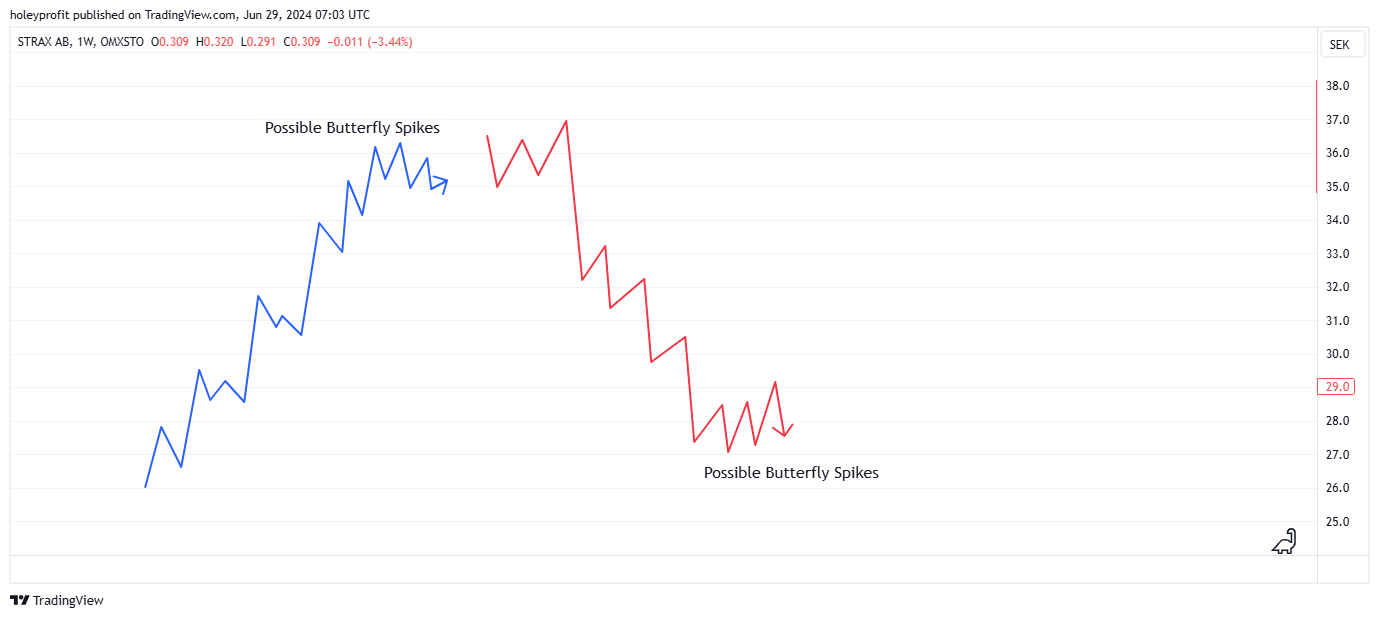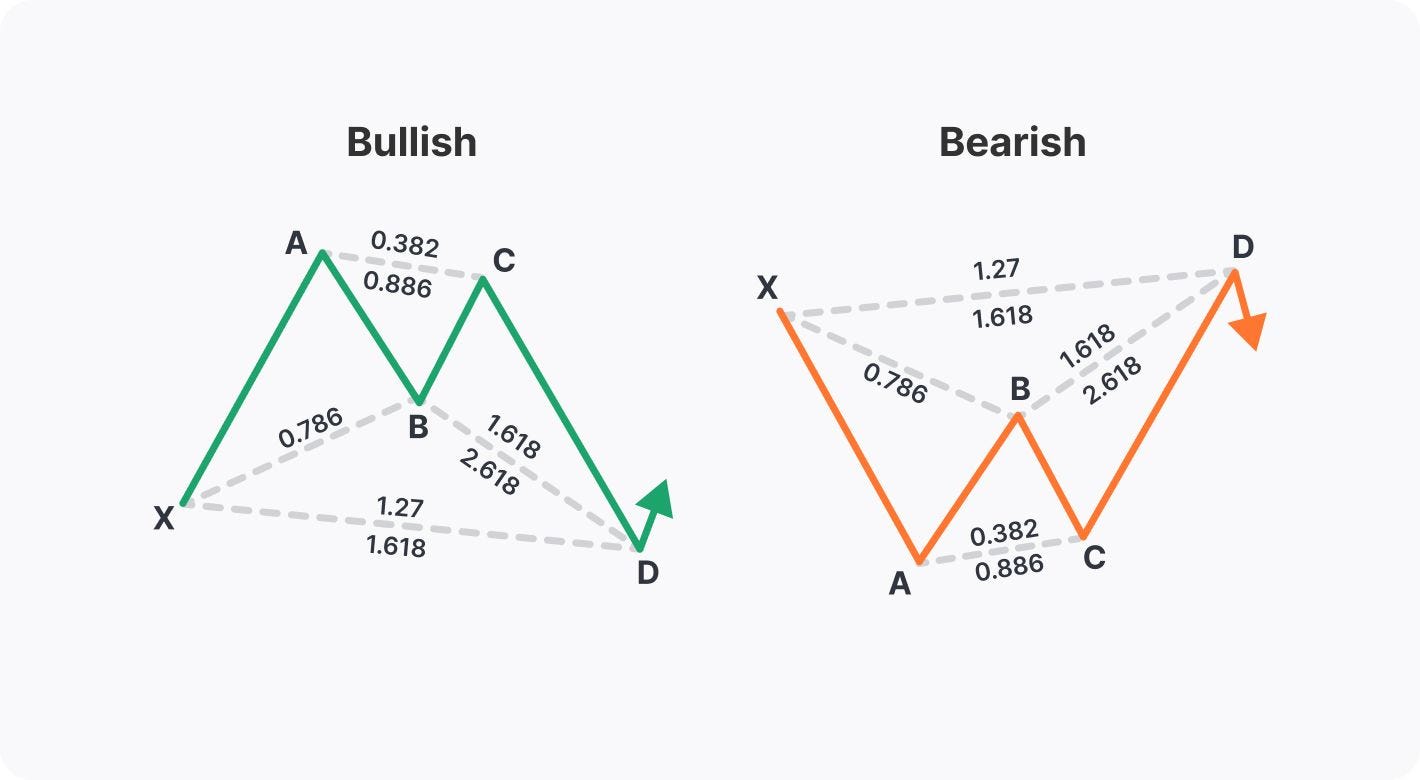This is part of a series of strategy posts.
Once all strategy posts are up, they will be linked together. Initially there will be placeholders for links - Marked “(Link)”. This is because all posts need to be published to be able to interlink them. Please check back later for complete interlinking.
The original series of posts will contain 15 strategies. All of them time tested and ones I’ve personally used to make a living in markets for over 10 years. These will all be free. Multiple additional posts will be added for paid members. Discussing advanced strategy, nuances and covering the common questions we’d expect about the strats.
Strategy Name:
- Harmonic Butterfly Blow Off Pattern
Strategy Type:
- Reversal
Strategy Premise Overview:
- The Harmonic Butterfly Blow Off Pattern strategy identifies potential market reversals after a persistent trend followed by an aggressive spike.
-This pattern uses the harmonic butterfly structure, characterized by a W-shaped formation for the end of an uptrend and a M-shaped formation for the end of a downtrend. This produces a final false breakout before a larger correction or all our reversal.
Conditions for Use:
- This strategy is best applied in markets that have been trending persistently and show signs of an aggressive spike or blow-off move.
- The trend should be really extended and for best results this strategy should also be matched up with some type of other method of determining trend exhaustion such as support and resistance or Elliot wave (Link).
Planning Entries:
- The first thing to do for this strategy is to determine a zone in which you’re looking to use it. Usually using some kind of trend theory and or support/resistance. It is important to plan areas to use this strategy to help to filter out some of the false signals it can produce. Plan big levels where the trend may be exhausted and set price alerts on them.
- Harmonic patterns take multiple swings to build up. Look for attempted reversals. Things like double bottoms in an uptrend and double tops in a downtrend. When we have these, we potentially have the XABC section of the harmonic. We can then make plans to enter after the D leg.
- The full structure of a harmonic butterfly looks like this.
- Once the XABC sections are in, limit orders can be placed at the 1.61 for a reversal. Alternatively, a price alert can be placed on 1.61 and entries can be taken if there is some sort of pin bar or other reversal pattern.
-Here the black section shows where the obvious trend ends and when we can watch list the butterfly spike out pattern.
Planning Stops:
- Stops on this pattern go behind the 2.20 at the widest. Note, this is different from the default butterfly rules which state 1.61 - 2.61 as the possible reversal area. My findings are if the reversal does not come before 2.20, 2.61 hits most of the time. Better to stop out and have the option of trading again at 2.61 if you want to keep betting on the reversal.
- Tighter stops can be taken using things like candle patterns. Small chart head and shoulders patterns and things of the like. These have much higher RR but run the risk of being spiked out before the real move comes more often.
Planning Targets:
- The first major potential support level is a 76% retracement of the D leg. This is where we can see the simple 76 Continuation trade (Link) and is a place we should at the very least move our stops to even.
- A full target for this trade can usually be best defined by drawing an extension fib from the B-D leg of the harmonic and targeting a 1.61 extension.
- 1.61 extensions are commonly the end of bigger corrections. A trend continuation pattern can come here (Link) but the breaking of this can lead to much stronger moves. Trailing stops can help to increase the overall RR by catching big moves when there are 1.61 breaks (Links).
Typical Win Path:
- Successful trades will see the price reverse sharply after completing the D leg at the 1.61 Fibonacci extension of the BC leg.
- Look for confirmation through price action signals, such as wicks, reversal candlestick patterns and strong momentum dying abruptly around resistance.
- The reversal should lead to a significant retracement of the D leg, reaching the planned targets. Reversals from these setups come in an avalanche type of way. Building up slowly and then turning into a ferocious move. Patience around the potential reversal zone is needed. If and when the trade starts to pick up things should be fairly smooth.
-When the first target breaks, this trade has a 76 Failure trade in it.
-When the 76 failure trade works, then we trigger the conditions for the 1.27 Continuation trade.
Typical Lose Path:
- Failed trades may occur if the price continues to move beyond the 1.61 Fibonacci extension of the BC leg, hitting the stop loss at the 2.20 extension.
- Sometimes there will be strong momentum through the 2.20 and sometimes we’ll see a 2.20 to 1.27 pullback (Link). The risk of strong counter moves against our trades is too strong to take chances. For risk protection it is best to assume failure of 2.20 can lead to sustained action against your position and trigger a quick stop out.
- This strategy has a counter strategy that can be used when it fails. (Link).
Why Strategy is Expected to be Successful:
- The strategy leverages the harmonic butterfly pattern, a well-documented reversal pattern with a high probability of success when correctly identified.
- It provides clear entry and exit points, allowing for precise risk management and favorable risk-reward ratios.
- The pattern often appears at market extremes, capturing significant reversals and profiting from major trend changes.
Known Risks and Weaknesses:
- The strategy is vulnerable to strong, persistent trends where the reversal pattern may fail to hold.
- Requires accurate identification of the harmonic butterfly pattern and the correct application of Fibonacci extensions.
- Can produce lots of false signals when traded against a trend. Taking every instance of this type of signal against a trend would have an expectation of breaking even if you did it perfectly, and generating losses otherwise. Lots of failed harmonics form in a developing trend.
Trade Plan Execution
Bullish Execution Plan for the Harmonic Butterfly Blow Off Pattern:
Step 1: Market Analysis
- Identify a market with a persistent downtrend and signs of an aggressive spike or blow-off move.
- Confirm the trend direction (downtrend) by analyzing lower lows and lower highs.
- Determine key support and resistance levels to filter out false signals.
Step 2: Identify Harmonic Pattern Setup
- Look for double bottoms or similar reversal patterns indicating potential trend exhaustion.
- Confirm the formation of the XABC sections of the harmonic butterfly pattern.
Step 3: Draw Fibonacci Extensions
- Draw Fibonacci extension levels from the B to D leg of the harmonic pattern.
- Identify the 1.61 Fibonacci extension of the BC leg as the key level for entry.
Step 4: Set Alert
- Set an alert slightly past the 1.61 Fibonacci extension level to notify you when the price approaches this key level.
Step 5: Confirmation and Entry
- Monitor the price action as it nears the 1.61 Fibonacci extension level.
- Look for reversal candlestick patterns or other signs of strong momentum dying around resistance.
- Enter a long trade by placing a limit order at the 1.61 Fibonacci extension level or use reversal candlestick patterns for confirmation.
Step 6: Place Stop Loss
- Set a stop loss slightly below the 2.20 Fibonacci extension level.
- Alternatively, place the stop loss below the most recent local swing low to allow for some volatility.
Step 7: Manage Trade
- As the price moves in your favor, monitor the price action around the 76% retracement of the D leg.
- Be prepared for sharp corrections and possible retests of the 1.61 Fibonacci level.
Step 8: Set Targets
- The initial target is near the 76% retracement of the D leg.
- If the price continues to show strong momentum, consider holding for the 1.61 Fibonacci extension of the B-D leg.
- Use a trailing stop to manage the trade beyond the 76% level, locking in profits as the price moves higher.
Bearish Execution Plan for the Harmonic Butterfly Blow Off Pattern:
Step 1: Market Analysis
Identify a market with a persistent uptrend and signs of an aggressive spike or blow-off move.
Confirm the trend direction (uptrend) by analyzing higher highs and higher lows.
Determine key support and resistance levels to filter out false signals.
Step 2: Identify Harmonic Pattern Setup
Look for double tops or similar reversal patterns indicating potential trend exhaustion.
Confirm the formation of the XABC sections of the harmonic butterfly pattern.
Step 3: Draw Fibonacci Extensions
Draw Fibonacci extension levels from the B to D leg of the harmonic pattern.
Identify the 1.61 Fibonacci extension of the BC leg as the key level for entry.
Step 4: Set Alert
Set an alert slightly past the 1.61 Fibonacci extension level to notify you when the price approaches this key level.
Step 5: Confirmation and Entry
Monitor the price action as it nears the 1.61 Fibonacci extension level.
Look for reversal candlestick patterns or other signs of strong momentum dying around resistance.
Enter a short trade by placing a limit order at the 1.61 Fibonacci extension level or use reversal candlestick patterns for confirmation.
Step 6: Place Stop Loss
Set a stop loss slightly above the 2.20 Fibonacci extension level.
Alternatively, place the stop loss above the most recent local swing high to allow for some volatility.
Step 7: Manage Trade
As the price moves in your favor, monitor the price action around the 76% retracement of the D leg.
Be prepared for sharp corrections and possible retests of the 1.61 Fibonacci level.
Step 8: Set Targets
The initial target is near the 76% retracement of the D leg.
If the price continues to show strong momentum, consider holding for the 1.61 Fibonacci extension of the B-D leg.
Use a trailing stop to manage the trade beyond the 76% level, locking in profits as the price moves lower.
HoleyProfit’s Strategies is a reader-supported publication. To receive new posts and support my work, consider becoming a free or paid subscriber.














